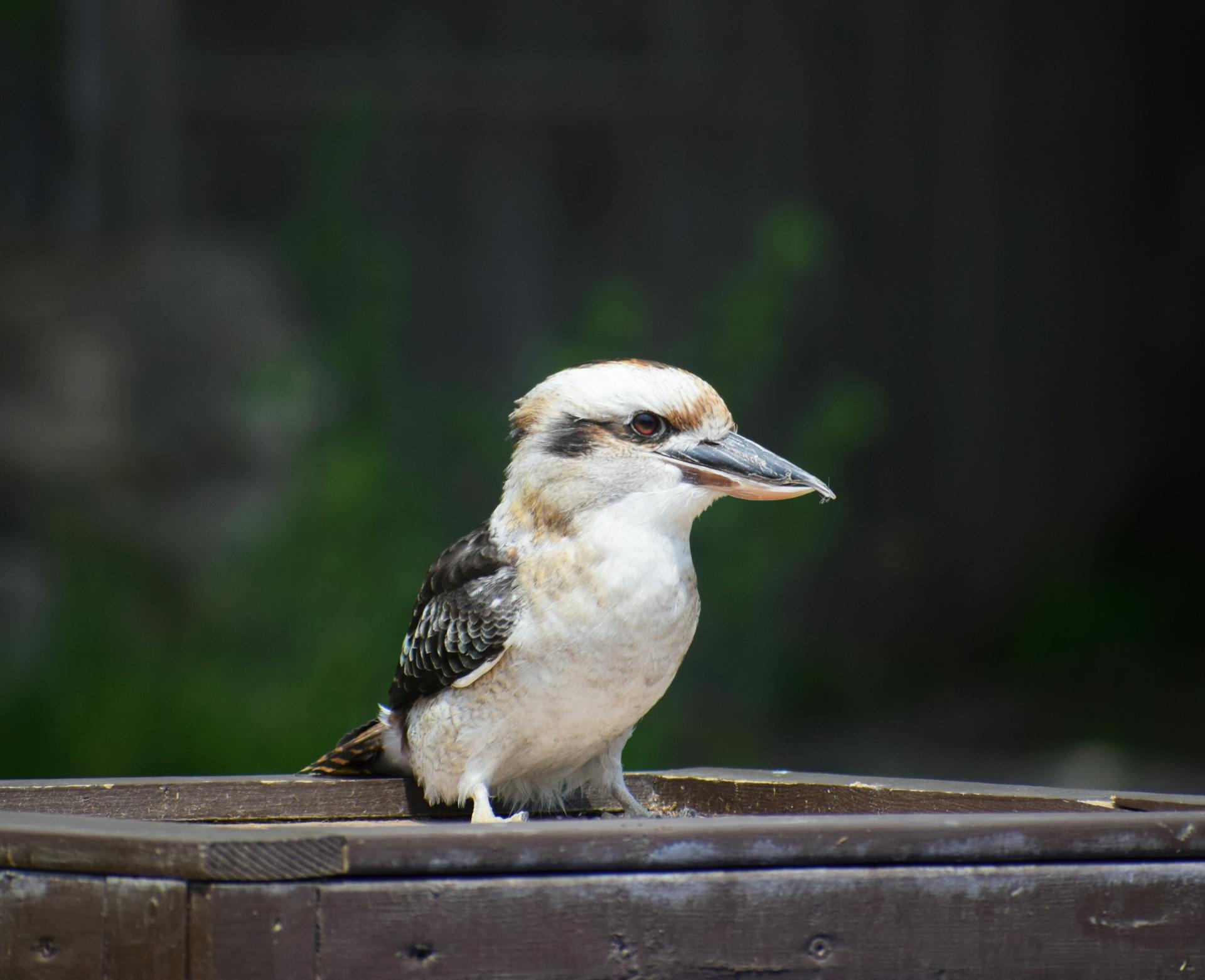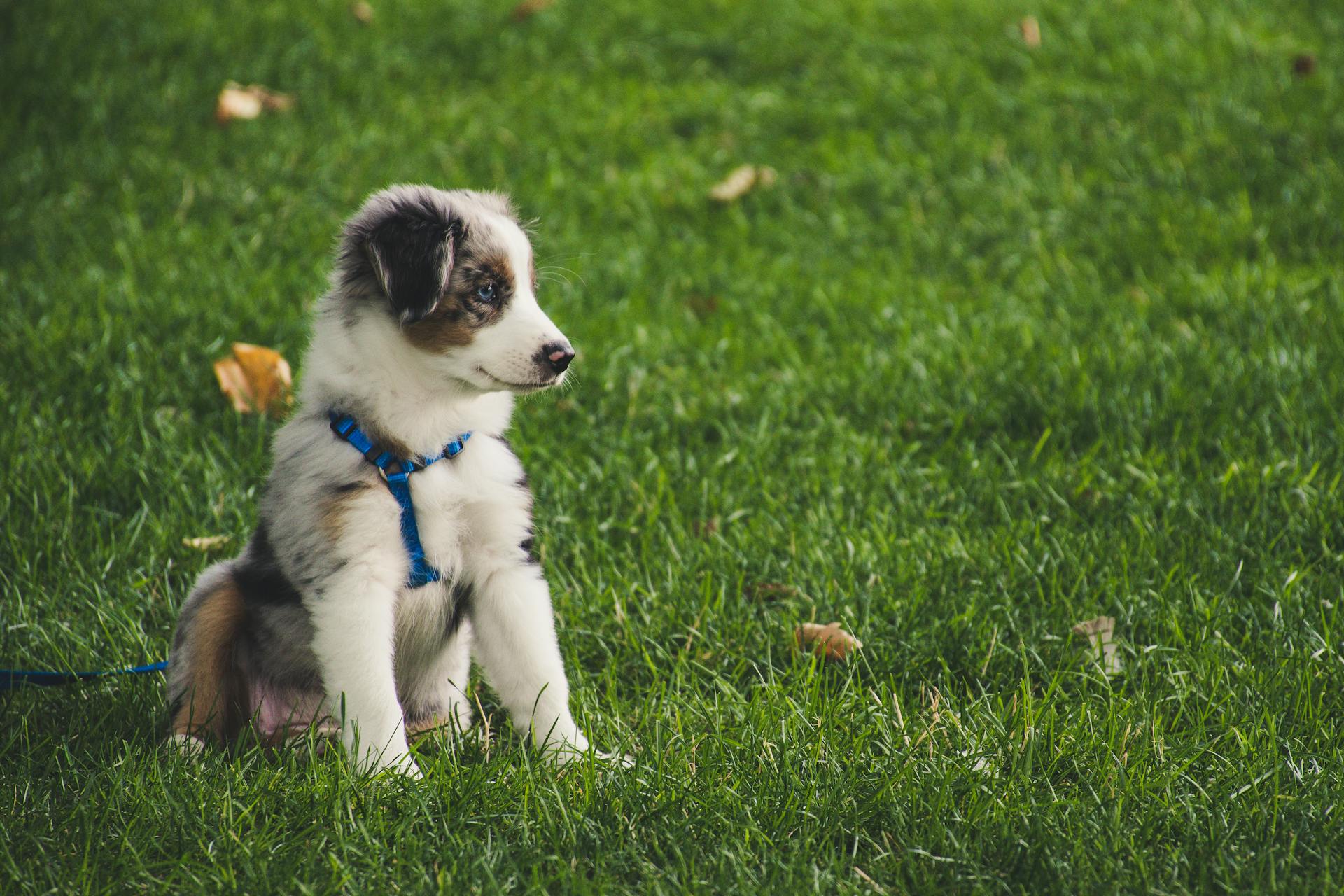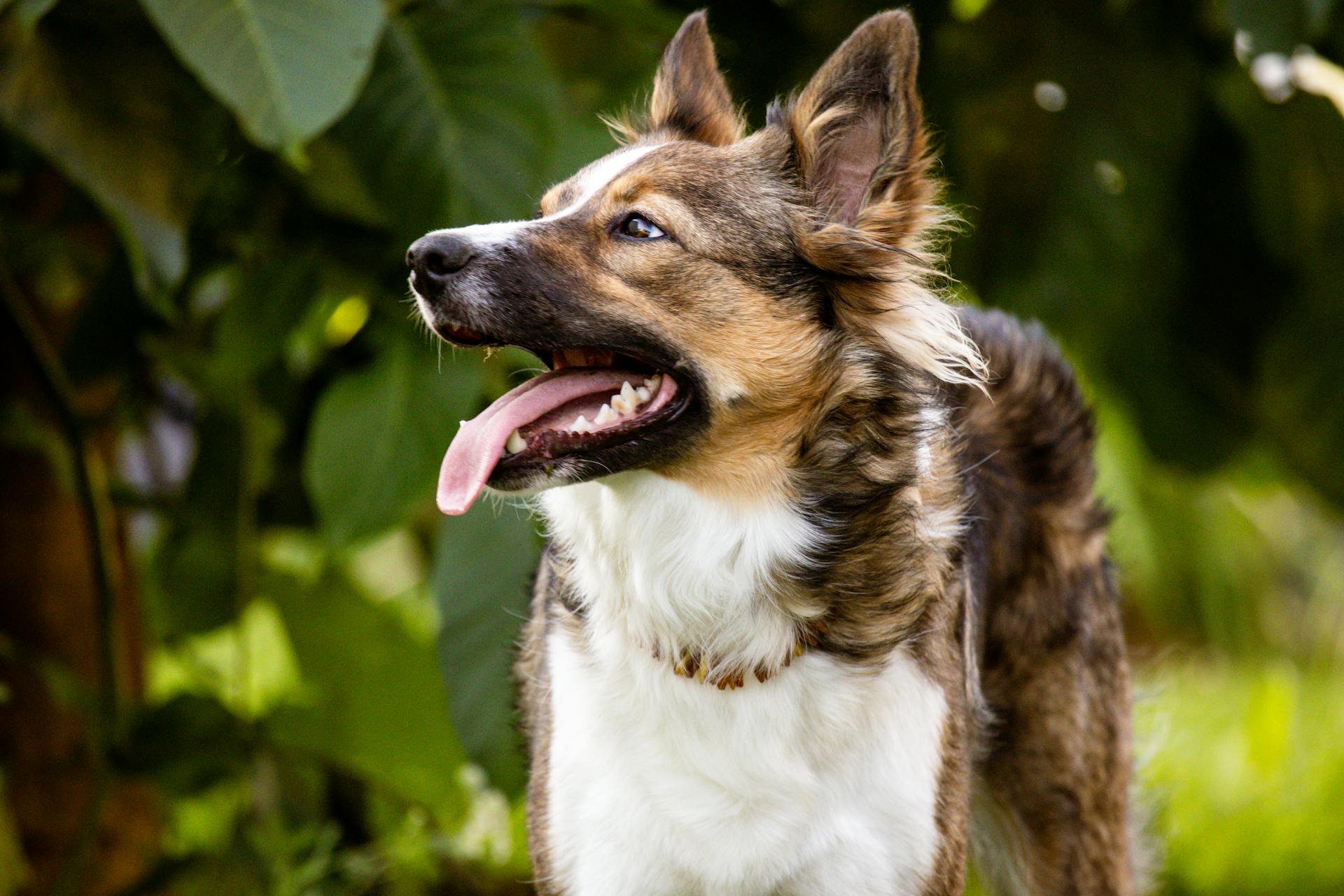
The Red Australian Shepherd is a stunning breed with a rich history. They originated in the United States in the 19th century.
This breed was developed from the Australian Shepherd's ancestors, who were brought to the US by Basque sheep herders. Their intelligence and agility made them perfect for herding.
Red Australian Shepherds are highly intelligent and active dogs that require regular exercise and mental stimulation. They thrive on physical and mental challenges.
They are naturally protective of their family and territory, but can be wary of strangers. Early socialization is key to helping them feel comfortable around new people.
For another approach, see: Red Miniature American Shepherd
Physical Characteristics
The Red Australian Shepherd is a beautiful breed with a well-balanced and agile build, reflecting their herding heritage. Their body is slightly longer than their height, with a level back and well-developed muscles.
One of the most captivating features of Australian Shepherds is their eyes, which are often striking and almond-shaped, and can be blue, brown, or even one of each (heterochromia). Some dogs even have marbled eyes, with mixed colors within one eye.
Their ears are medium-sized, triangular in shape, and slightly folded. They have a cute natural bobtail or a short tail.
The Red Australian Shepherd is a medium-sized breed, typically standing 18-23 inches tall at the shoulder. They weigh between 40-65 pounds, making them a great companion for active families.
See what others are reading: Red Husky Shepherd Mix
Temperament and Health
Red Australian Shepherds are generally a healthy breed, but like all breeds, they can be prone to certain health issues. Studies have shown that they may be susceptible to common joint and bone issues like arthritis and hip dysplasia.
Their eyes are also a concern, with Collie Eye Anomaly (CEA) being a genetic issue that affects 9% of Collies. Other eye issues include cataracts, conjunctivitis, and glaucoma.
It's essential to find a reputable breeder who performs health screenings on their breeding dogs to reduce the risk of these health conditions. They can also help identify potential issues early on.
Some potential health issues to be aware of include:
- Arthritis and hip dysplasia
- Collie Eye Anomaly (CEA)
- Cataracts, conjunctivitis, and glaucoma
- Multidrug Resistance 1 (MDR1) Gene Mutation
- Lymphoma
- Heart conditions, including congenital heart defects and mitral valve disease
- Autoimmune disorders, such as autoimmune thyroiditis and autoimmune skin conditions
- Merle-Associated Issues such as blindness and deafness for Red Merles
- Moderate issues like obesity, dental issues, ear infections, and allergies
Temperament and Behavior
Red Australian Shepherds are highly active dogs that require plenty of exercise and mental stimulation to prevent boredom and destructive behavior. They need at least one to two hours of exercise per day to stay settled.
These dogs are intelligent and adaptable, making them excellent family pets. They are affectionate and protective of their families, but may be reserved or wary around strangers if not properly socialized.
Red Australian Shepherds are highly trainable and excel in obedience, agility, and other dog sports. They thrive on positive reinforcement training methods and enjoy learning new commands and tasks.
They have a strong herding instinct and may try to herd children, other pets, or even cars if not adequately trained and supervised. This can be upsetting for small children and may lead to safety risks if not addressed.
Here are some key temperament traits to keep in mind when considering a Red Australian Shepherd:
Overall, Red Australian Shepherds make excellent family pets for active families who can provide the necessary exercise and training. With proper socialization and training, they can be wonderful companions and thrive in various living situations.
Life Expectancy
A Red Australian Shepherd's life expectancy is typically between 12 to 15 years.
Genetics play a significant role in determining their lifespan, along with their diet, exercise, and overall health.
Proper nutrition is essential for maintaining their overall health, and a well-balanced diet can help them live a long and healthy life.
Regular exercise is also crucial, as it helps maintain their physical and mental well-being.
Eye Colors
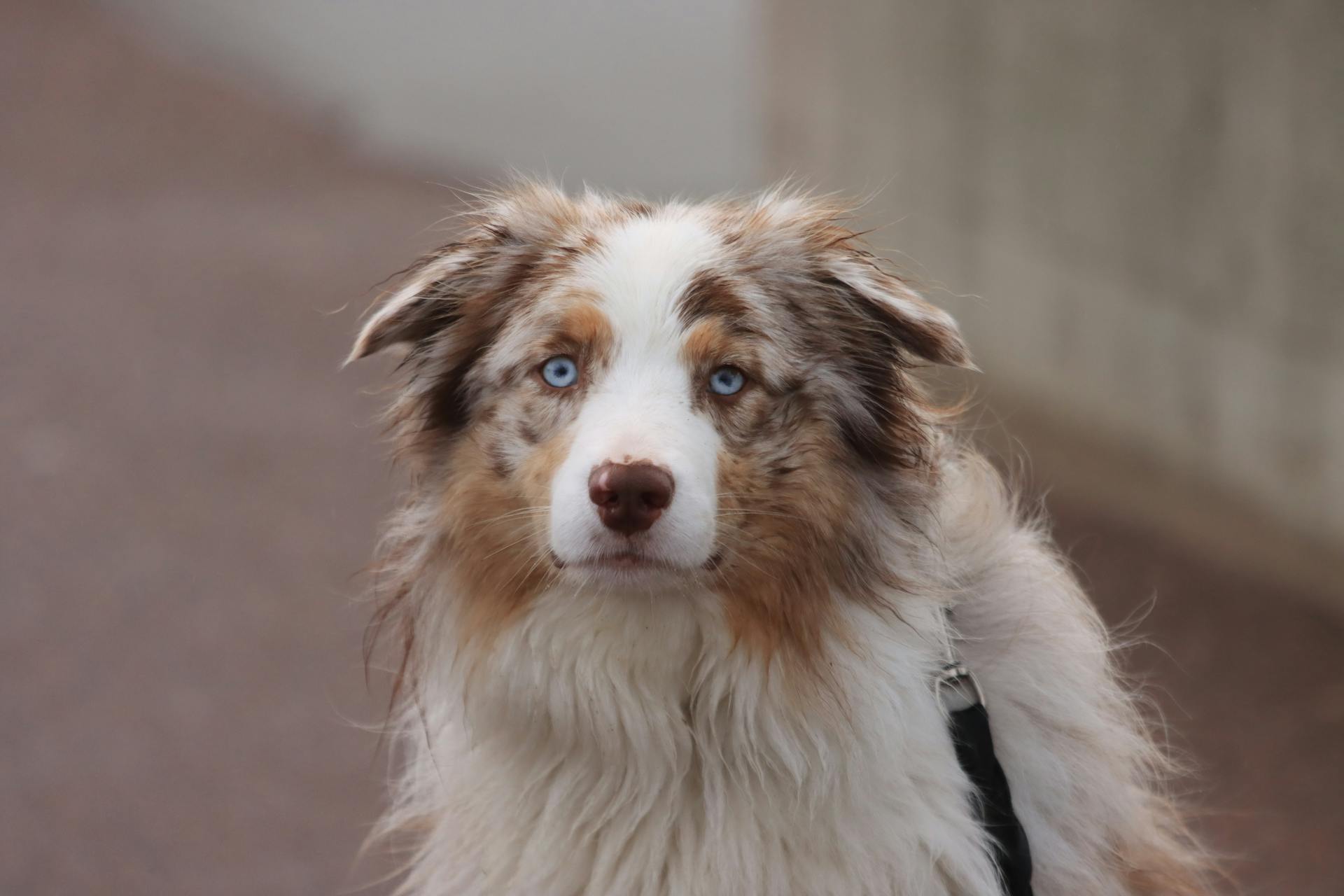
Australian Shepherds can have a wide range of eye colors, including blue, brown, amber, and even heterochromia.
Their eye color can vary widely, often with marbling or flecks, which adds to their unique appearance.
In fact, red Merle Australian Shepherds can have eye colors that range from blue to amber or even green, making them truly one-of-a-kind.
Their diverse range of eye colors is just one of the many factors that contribute to their stunning appearance.
Red Merle Australian Shepherds are particularly stunning in the sunlight, and their eye colors often seem to glow.
The combination of coat colors and eye colors in Australian Shepherds is truly remarkable, and it's what makes them so beloved by many dog owners.
See what others are reading: Red Eyes in German Shepherds
Born with Short Tails
Some Red Tri Australian Shepherds are born with short tails, a naturally occurring trait in about one in five pups.
These dogs didn't have their tails docked through elective surgery.
Red Tri Australian Shepherds born with short tails are often considered more desirable by some, which can make them a bit more expensive than their counterparts with regular-length tails.
Intriguing read: Australian Shepherds Good Apartment Dogs
Care and Maintenance
To keep your red Australian Shepherd's coat healthy, it's essential to provide shade and fresh water during hot weather to prevent dehydration and overheating. This will help prevent damage to the coat.
Regular brushing is crucial to control shedding, especially during shedding seasons. Invest in a de-shedding tool or a grooming glove to remove loose hair.
Health monitoring is also vital, with regular vet check-ups allowing you to address any coat-related concerns early on and prevent more serious conditions from developing.
Here's an interesting read: Red Golden Retriever Colors
Care and Maintenance
Australian Shepherds are known to be moderate to heavy shedders, especially during shedding seasons. Regular brushing helps to control shedding by removing loose hair before it accumulates in the coat.
To keep your Australian Shepherd's coat healthy, provide shade and fresh water during hot weather to prevent dehydration and overheating. This will also help prevent damage to their coat.
Regular health check-ups with your veterinarian are crucial for maintaining overall coat health. They can assess the condition of the coat, check for any skin issues or parasites, and address any concerns you may have.
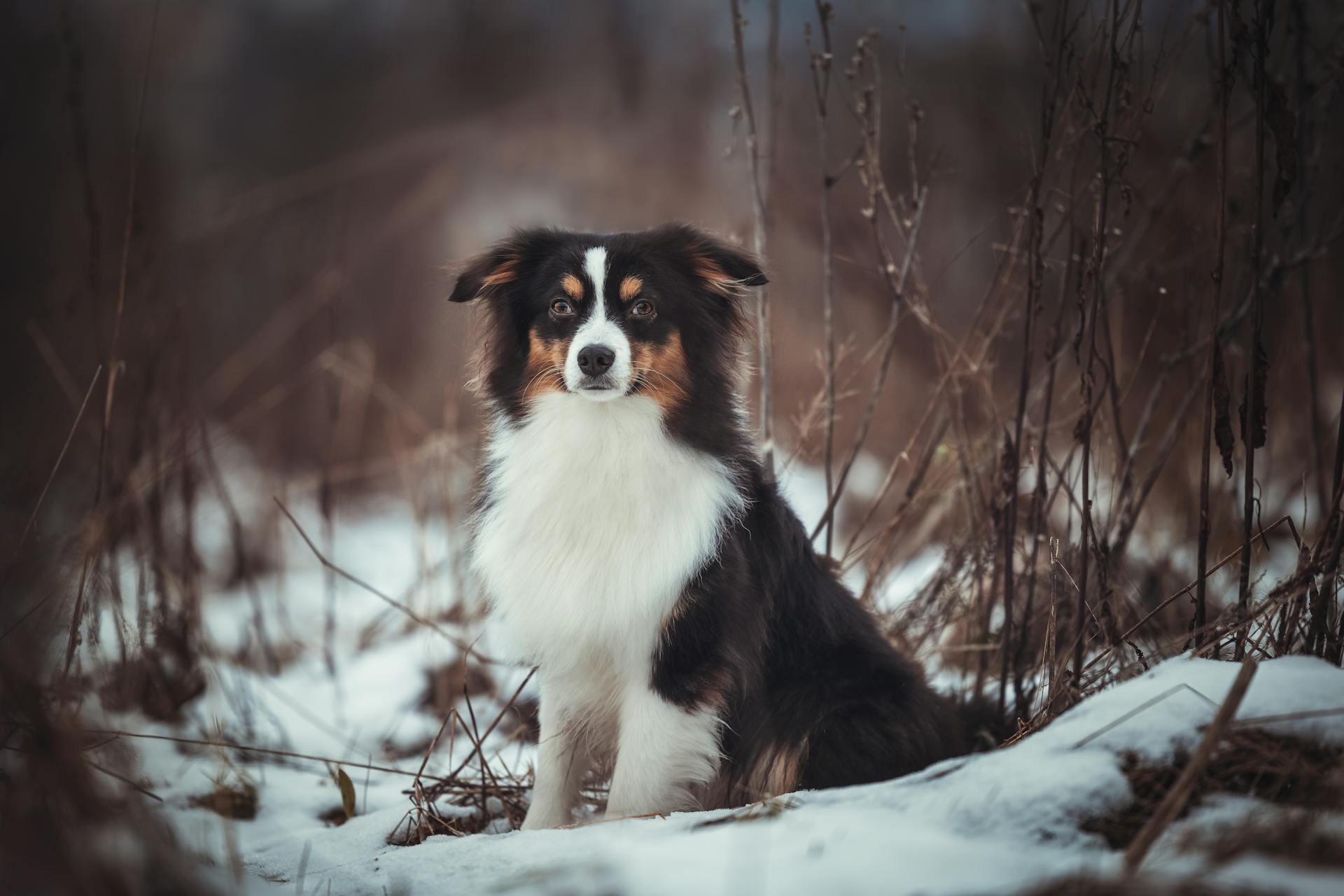
Invest in a de-shedding tool or a grooming glove specifically designed for removing loose hair to make brushing easier and more effective. This will help keep shedding under control during shedding seasons.
A balanced diet and supplements recommended by your veterinarian can also support coat health and reduce excessive shedding.
Exercise Requirements
Exercise is essential for Red Australian Shepherds, and they need at least 1 to 2 hours of exercise daily. This can include activities like walking, running, and playing fetch.
Regular physical exercise will keep your Red Australian Shepherd happy and healthy. Owners should aim for 1 to 2 hours of exercise daily.
Mental stimulation is just as crucial as physical exercise for Red Australian Shepherds. Providing puzzle toys, agility courses, and obedience training can keep their minds active.
Puzzle toys are a great way to challenge your Red Australian Shepherd's mind and prevent boredom.
Curious to learn more? Check out: Australian Shepherds Water Dogs
Finding and Breeding
Finding a red Australian Shepherd can be a rewarding experience, but it's essential to do it right. You have two main options: finding a reputable breeder or adopting from a rescue or shelter.
A reputable breeder is crucial when looking for a red Australian Shepherd. Look for breeders registered with the Australian Shepherd Club of America (ASCA) or the American Kennel Club (AKC).
Here are some tips to find a reputable breeder:
- Look for breeders registered with the Australian Shepherd Club of America (ASCA) or the American Kennel Club (AKC).
- Visit the breeder’s facility and meet the puppies’ parents to ensure they are healthy and well-cared for.
- Ask for health clearances for the parents, including hip and elbow dysplasia, eye exams, and genetic testing for common breed-specific diseases.
- Ask for references from previous puppy buyers and contact them about their experience with the breeder.
History and Origin
The Australian Shepherd's history is a fascinating tale of migration and adaptation. The breed was brought from the Basque region of Spain, where Basque Shepherds bred capable herding dogs.
These Basque shepherds migrated to California, where the breed was refined into the Australian Shepherd we know today. This explains why Australian Shepherds have the name Australia, despite not being from the country of origin.
The breed's original purpose was herding, and they excelled at it. They're still a popular choice on cattle ranches today across America.
Australian Shepherds are fearless and speedy, with a reputation for being able to turn on a dime. This makes them excellent cattle driving dogs.
The breed's coat colors are wide-ranging, but regardless of appearance, Australian Shepherds have the same personality traits, health predispositions, and exercise needs.
The red coat color is recessive, meaning a puppy needs to inherit two recessive red coat color genes to show a red coat color.
Expand your knowledge: Australian Cattle Dog
Finding
Finding a red Australian Shepherd can be a rewarding experience, but it's essential to do it responsibly. You have two main options: finding a reputable breeder or adopting from a rescue or shelter.
Finding a reputable breeder is crucial to ensure you get a healthy and well-socialized puppy. Look for breeders registered with the Australian Shepherd Club of America (ASCA) or the American Kennel Club (AKC).
Visiting the breeder's facility and meeting the puppies' parents is a must to ensure they are healthy and well-cared for. Ask for health clearances for the parents, including hip and elbow dysplasia, eye exams, and genetic testing for common breed-specific diseases.
Asking for references from previous puppy buyers and contacting them about their experience with the breeder can give you valuable insight. It's also a good idea to ask the breeder about any guarantees or support they offer for the puppy's health and behavior.
Consider reading: Red Heeler Lab Mix Dog
Adopting a red Australian Shepherd from a rescue or shelter can be an excellent option for those who want to give a loving home to a dog in need. Research the rescue or shelter to ensure they have a good reputation and are transparent about the dog's history and behavior.
Meeting the dog in person and spending time with them can help you see if their personality and energy level fit your lifestyle. Ask the rescue or shelter staff about any medical or behavioral issues the dog may have and ensure you are prepared to handle them.
Here are a few reputable rescue organizations to consider:
- Australian Shepherd Rescue Midwest;
- Aussie Rescue & Placement Helpline (ARPH);
- NorCal Aussie Rescue;
- South Texas Aussie Rescue (STAR); and
- New Spirit 4 Aussie Rescue.
Color and Coat
The red Australian Shepherd has a predominantly red coat that can vary from light cinnamon color to deep mahogany.
Their coat is thick and double-layered, with a soft undercoat and a longer, coarser topcoat that protects from the elements.
Red Australian Shepherds often have white or black markings on the face, chest, and legs.
The mottled merle pattern is also common in this breed.
Their coat can have a bi-color variation, typically involving a predominantly white coat with solid patches of color, such as black, red, blue, or chocolate.
The red Australian Shepherd's coat is a result of the interaction of multiple genes, including those responsible for the production and distribution of eumelanin and pheomelanin.
Health and Genetics
Red Australian Shepherds can be prone to joint and bone issues like arthritis and hip dysplasia. These health problems can be a concern for any dog owner.
To reduce the risk of these health conditions, it's essential to find a reputable breeder who performs health screenings on their breeding dogs. This can include checking for genetic issues like the MDR1 Gene Mutation, which affects the transport of drugs.
Red Australian Shepherds may also be more prone to eye issues like Collie Eye Anomaly (CEA), which can cause blindness. Other eye problems include cataracts, conjunctivitis, and glaucoma.
If this caught your attention, see: Red Heeler Behavior Problems
Some Australian Shepherds may be born with heart conditions, including congenital heart defects and mitral valve disease. Autoimmune disorders, such as autoimmune thyroiditis and autoimmune skin conditions, can also be a concern.
Merle Australian Shepherds, including Blue Merle and Red Merle, can be more prone to health issues due to the genetic complexity associated with the merle coloration. This can include increased risk for deafness and blindness, particularly in double-merle offspring.
Here are some common health issues that can affect Red Australian Shepherds:
- Arthritis and hip dysplasia
- Eye issues like Collie Eye Anomaly (CEA)
- MDR1 Gene Mutation
- Heart conditions like congenital heart defects and mitral valve disease
- Autoimmune disorders like autoimmune thyroiditis and autoimmune skin conditions
- Merle-Associated Issues like blindness and deafness
- Obesity, dental issues, ear infections, and allergies
Frequently Asked Questions
How rare are red Australian Shepherds?
Red Australian Shepherds are relatively rare due to the recessive nature of the red gene. They are one of the more common red-colored coats in the breed, but still a less common occurrence than blue merles.
How much are red Australian Shepherds?
The cost of a red Australian Shepherd from a reputable breeder is typically between $600 and $1,200, with additional adoption fees for rescue options. Prices may vary depending on factors such as bloodline, health clearances, and breeder reputation.
Sources
- https://pawsafe.com/blogs/dog-breeds/red-australian-shepherd
- https://timberwolfpet.com/blogs/dog-facts/red-australian-shepherd-origin-colors-and-characteristics
- https://iheartdogs.com/australian-shepherd-colors-stunning-variations-with-pictures/
- https://www.dogster.com/dog-breeds/red-tri-australian-shepherd
- https://blog.tryfi.com/australian-shepherd-colors/
Featured Images: pexels.com
